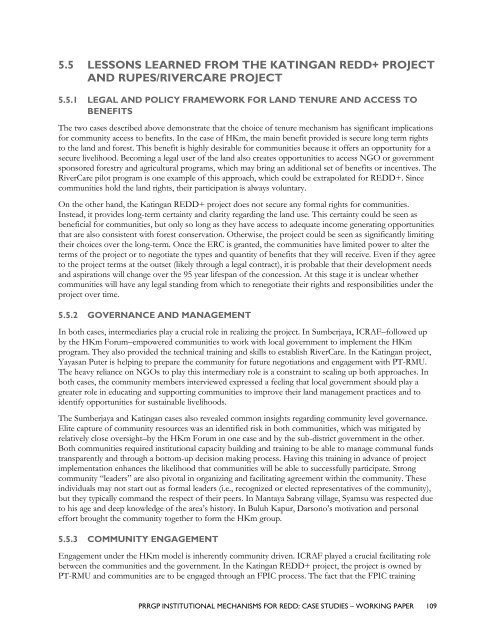Institutional Mechanisms for REDD+ - Case Studies Working Paper
Institutional Mechanisms for REDD+ - Case Studies Working Paper
Institutional Mechanisms for REDD+ - Case Studies Working Paper
Create successful ePaper yourself
Turn your PDF publications into a flip-book with our unique Google optimized e-Paper software.
5.5 LESSONS LEARNED FROM THE KATINGAN <strong>REDD+</strong> PROJECT<br />
AND RUPES/RIVERCARE PROJECT<br />
5.5.1 LEGAL AND POLICY FRAMEWORK FOR LAND TENURE AND ACCESS TO<br />
BENEFITS<br />
The two cases described above demonstrate that the choice of tenure mechanism has significant implications<br />
<strong>for</strong> community access to benefits. In the case of HKm, the main benefit provided is secure long term rights<br />
to the land and <strong>for</strong>est. This benefit is highly desirable <strong>for</strong> communities because it offers an opportunity <strong>for</strong> a<br />
secure livelihood. Becoming a legal user of the land also creates opportunities to access NGO or government<br />
sponsored <strong>for</strong>estry and agricultural programs, which may bring an additional set of benefits or incentives. The<br />
RiverCare pilot program is one example of this approach, which could be extrapolated <strong>for</strong> <strong>REDD+</strong>. Since<br />
communities hold the land rights, their participation is always voluntary.<br />
On the other hand, the Katingan <strong>REDD+</strong> project does not secure any <strong>for</strong>mal rights <strong>for</strong> communities.<br />
Instead, it provides long-term certainty and clarity regarding the land use. This certainty could be seen as<br />
beneficial <strong>for</strong> communities, but only so long as they have access to adequate income generating opportunities<br />
that are also consistent with <strong>for</strong>est conservation. Otherwise, the project could be seen as significantly limiting<br />
their choices over the long-term. Once the ERC is granted, the communities have limited power to alter the<br />
terms of the project or to negotiate the types and quantity of benefits that they will receive. Even if they agree<br />
to the project terms at the outset (likely through a legal contract), it is probable that their development needs<br />
and aspirations will change over the 95 year lifespan of the concession. At this stage it is unclear whether<br />
communities will have any legal standing from which to renegotiate their rights and responsibilities under the<br />
project over time.<br />
5.5.2 GOVERNANCE AND MANAGEMENT<br />
In both cases, intermediaries play a crucial role in realizing the project. In Sumberjaya, ICRAF–followed up<br />
by the HKm Forum–empowered communities to work with local government to implement the HKm<br />
program. They also provided the technical training and skills to establish RiverCare. In the Katingan project,<br />
Yayasan Puter is helping to prepare the community <strong>for</strong> future negotiations and engagement with PT-RMU.<br />
The heavy reliance on NGOs to play this intermediary role is a constraint to scaling up both approaches. In<br />
both cases, the community members interviewed expressed a feeling that local government should play a<br />
greater role in educating and supporting communities to improve their land management practices and to<br />
identify opportunities <strong>for</strong> sustainable livelihoods.<br />
The Sumberjaya and Katingan cases also revealed common insights regarding community level governance.<br />
Elite capture of community resources was an identified risk in both communities, which was mitigated by<br />
relatively close oversight–by the HKm Forum in one case and by the sub-district government in the other.<br />
Both communities required institutional capacity building and training to be able to manage communal funds<br />
transparently and through a bottom-up decision making process. Having this training in advance of project<br />
implementation enhances the likelihood that communities will be able to successfully participate. Strong<br />
community ―leaders‖ are also pivotal in organizing and facilitating agreement within the community. These<br />
individuals may not start out as <strong>for</strong>mal leaders (i.e., recognized or elected representatives of the community),<br />
but they typically command the respect of their peers. In Mantaya Sabrang village, Syamsu was respected due<br />
to his age and deep knowledge of the area‘s history. In Buluh Kapur, Darsono‘s motivation and personal<br />
ef<strong>for</strong>t brought the community together to <strong>for</strong>m the HKm group.<br />
5.5.3 COMMUNITY ENGAGEMENT<br />
Engagement under the HKm model is inherently community driven. ICRAF played a crucial facilitating role<br />
between the communities and the government. In the Katingan <strong>REDD+</strong> project, the project is owned by<br />
PT-RMU and communities are to be engaged through an FPIC process. The fact that the FPIC training<br />
PRRGP INSTITUTIONAL MECHANISMS FOR REDD: CASE STUDIES – WORKING PAPER 109

















